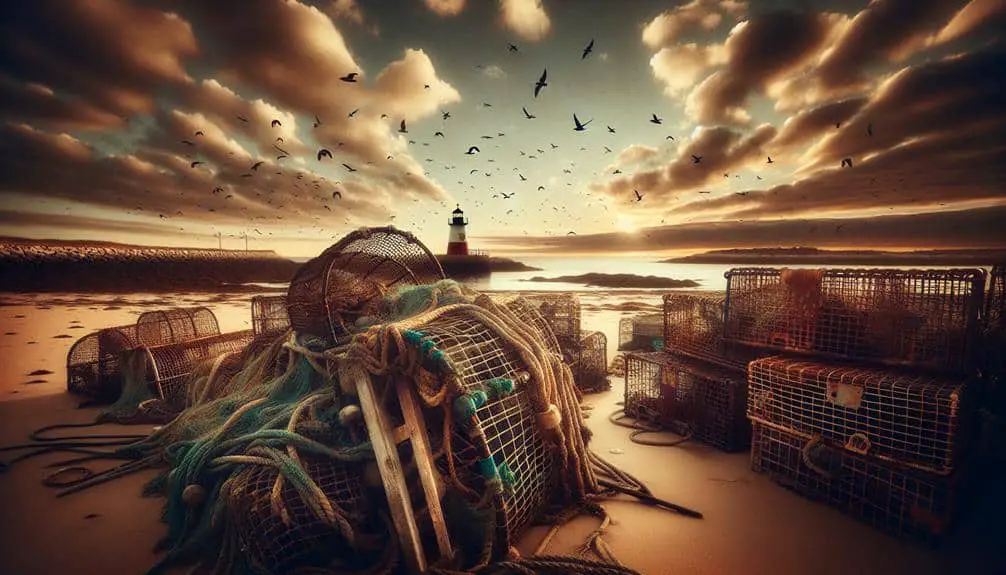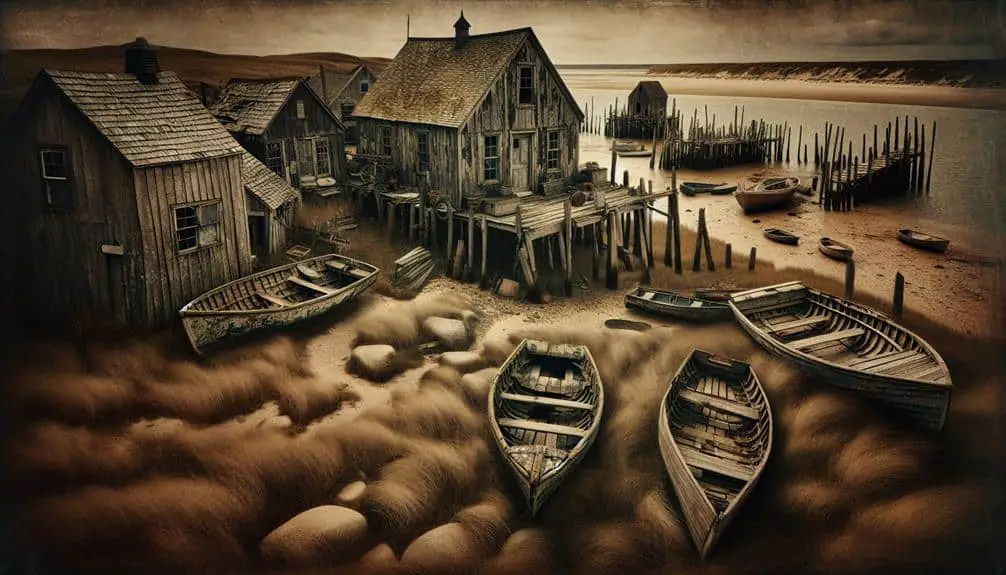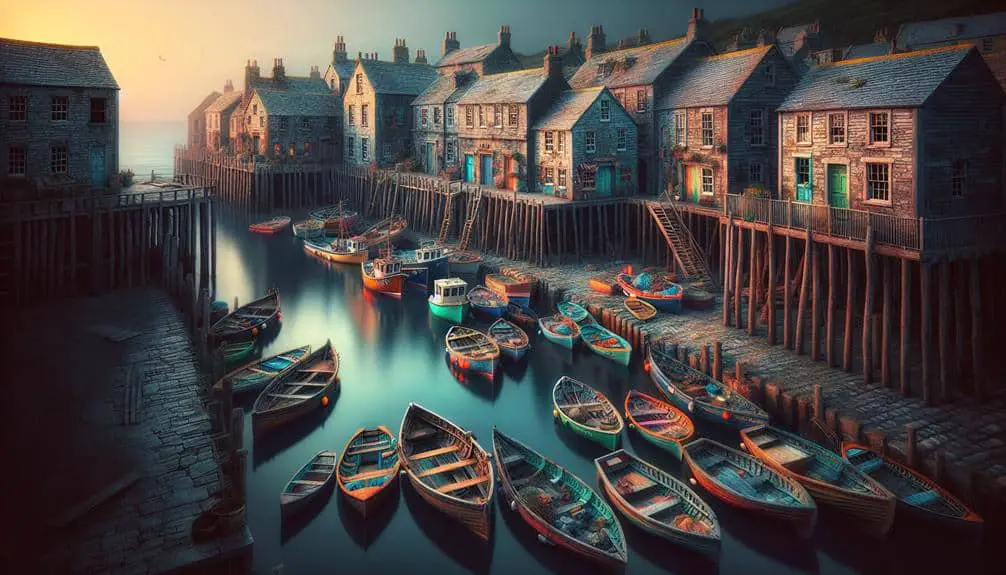Embark on a meticulous journey to discover coastal fishing village relics. Research historical maps, analyzing cartography for layout insights. Explore abandoned docks and fishermen's shacks. Utilize drone photography for aerial views. Scour beaches during low tide for artifacts. Visit local museums for tangible connections. Engage with interactive exhibits for immersive experiences. Conduct oral history interviews with long-time residents. Participate in historical tours to learn heritage. Use metal detectors on shorelines for relic discovery. Consult with experts for historical context. Your adventure to uncover coastal relics awaits, with each tip guiding you deeper into the rich history of these villages.
Key Points
- Utilize historical maps and documents for insights into coastal village relics.
- Explore abandoned docks, piers, and shacks for historical clues.
- Visit local museums for tangible connections to village history.
- Conduct oral history interviews with long-time residents for cultural insights.
- Consult with experts for guidance on artifact preservation and historical context.
Researching Historical Maps and Documents
When delving into the history of coastal fishing villages, begin by thoroughly examining historical maps and documents to uncover valuable insights into the past. Historical cartography analysis can provide you with detailed information about how these villages evolved over time.
Start your journey by delving into document archives, where hidden stories lie waiting to be discovered. Map interpretation is an essential skill in understanding the layout of these villages, showing you where old structures like docks and piers might've been located.
Archive research allows you to piece together the daily lives of the villagers, shedding light on their traditions and ways of living.
Exploring Abandoned Docks and Piers
Exploring the remnants of abandoned docks and piers uncovers a wealth of historical clues about the past maritime activities of the coastal fishing village. Underwater investigation around these deserted structures can reveal hidden treasures lost to time beneath the waves. Plunge into the waters near the docks to discover relics like old anchors, sunken boats, or even forgotten artifacts that illuminate the village's seafaring past.
For a different perspective, consider employing drone photography to capture stunning aerial views of the decaying docks and piers. Drones offer a unique vantage point, allowing you to survey the entire area from above and spot details that might be overlooked from the ground. These aerial views can provide valuable insights into the layout and size of the structures, offering a thorough understanding of how the docks once functioned and connected to the village.
Seeking Out Old Fishermens Shacks
As you begin your exploration of old fishermen's shacks, pay close attention to the unique architectural details that tell the story of these humble abodes.
Look out for historical fishing tools left behind, offering a glimpse into the traditional techniques used by local fishermen.
Engage with the stories shared by residents, as they provide valuable insights into the daily lives and challenges faced by those who once inhabited these coastal shacks.
Shack Architecture Details
Nestled along the rugged coastline are the remnants of old fishermen's shacks, each bearing unique architectural details that offer a glimpse into the past. As you explore these weathered structures, pay attention to the architectural features that define them.
Look for design elements like weathered shingles, simple pitched roofs, and sturdy wooden beams. The shacks often have small windows strategically placed to capture the sea breeze and maximize natural light. The use of reclaimed materials, such as driftwood or salvaged metal, adds character and tells a story of resourcefulness.
Take note of the modest size and efficient layout of these shacks, reflecting the practical needs of their former inhabitants. Each detail whispers tales of a bygone era, waiting to be discovered.
Historical Fishing Tools
In your quest to uncover the secrets of old fishermen's shacks, take a closer look at the historical fishing tools that once played an essential role in coastal village life. Fishing techniques have evolved over time, leading to changes in the tools used by fishermen.
Here are three key items that you might come across as you explore these relics:
- Handcrafted Wooden Fishing Nets: Witness the intricate craftsmanship of traditional fishing nets, meticulously woven by skilled hands to capture the day's catch.
- Rusty Fish Hooks on Weathered Lines: Imagine the patience required as fishermen cast their lines, each hook representing a moment of anticipation for a tug from the depths.
- Aged Fish Baskets: These worn containers tell stories of abundant hauls and the hard work of fishermen as they carried their treasures back to shore.
Local Fisherman Stories
Venture into the coastal landscapes to uncover the hidden tales of old fishermen's shacks, each structure holding echoes of a bygone era.
As you explore these weathered buildings, engage with the local community to unearth oral histories passed down through generations. Listen to folklore tales that intertwine with the very essence of these seaside dwellings, painting vivid pictures of life on the rugged shores.
The stories shared by seasoned fishermen reveal insights into their daily struggles, triumphs, and the deep connection they hold with the sea.
Scouring Beaches for Artifact Finds
When searching for artifact finds along the beaches of a coastal fishing village, pay close attention to the tide patterns and the erosion levels to maximize your chances of discovery. The coastline is a treasure trove waiting to be revealed, but it requires patience and a keen eye.
Here are three tips to enhance your beachcombing experience:
- Timing is Everything: Coordinate your artifact hunting with low tide periods when more of the beach is exposed, increasing your search area and the likelihood of finding hidden relics.
- Explore Erosion Hotspots: Focus on areas where erosion is more prominent, such as cliffs or rocky outcrops, as these locations are more likely to expose artifacts that have been previously buried.
- Scan the Wrack Line: The wrack line, where debris and seaweed accumulate, can also conceal small artifacts brought in by the tides. Take your time to sift through this area methodically.
Visiting Local Museums for Clues
When exploring coastal fishing village relics, visiting local museums can provide valuable insights into the community's history. Museum artifacts offer tangible connections to the past, while historical photos reveal hidden secrets waiting to be discovered.
Interactive exhibits within these museums can ignite your curiosity and enhance your understanding of the village's rich heritage.
Museum Artifacts Provide Insights
Exploring the local museums can provide valuable insights into the coastal fishing village relics, offering a deeper understanding of the community's maritime history and traditions. By delving into museum artifacts, you can reveal a treasure trove of information that illuminates the daily lives and practices of the village's inhabitants.
Here are three ways museum artifacts provide insights:
- Artifact Preservation: Witness well-preserved tools, pottery, and fishing equipment showcasing the craftsmanship and skills of the village's past generations.
- Cultural Significance: Discover how artifacts like clothing, jewelry, and religious items reflect the cultural beliefs and practices embedded in the fabric of the community.
- Historical Context: Trace the evolution of fishing techniques and boat-building methods through the artifacts on display, uncovering the historical context that shaped the village's identity.
Historical Photos Reveal Secrets
Exploring local museums for hints, historical photos expose secrets that reveal the hidden stories of the coastal fishing village's past. Within the archival treasures of these museums lie hidden mysteries waiting to be unraveled.
As you investigate the historical photos on display, pay attention to the details captured in each frame. Look for clues like old fishing techniques, traditional village celebrations, or changes in the landscape over time. These photos not only showcase the village's history but also provide a glimpse into the daily lives of its inhabitants.
Take your time examining each picture, as they hold invaluable insights that could shed light on the mysteries surrounding the coastal fishing village's heritage.
Interactive Exhibits Spark Curiosity
Reveal the mysteries of the coastal fishing village's past by engaging with the interactive exhibits at local museums, sparking a sense of curiosity that leads you on a journey of discovery. These interactive experiences offer a unique way to explore the history and culture of the village, providing immersive encounters that transport you back in time.
- Touchscreen Displays: Explore old maps, photos, and documents with the touch of your fingertips, uncovering the stories of the village's fishermen and their way of life.
- Virtual Reality Simulations: Immerse yourself in the life of a fisherman as you navigate the challenging waters, experiencing the obstacles they encountered firsthand.
- Hands-On Artifact Stations: Interact with historical artifacts such as fishing tools and traditional clothing, establishing a direct connection to the village's rich heritage.
Interviewing Long-Time Residents
When interviewing long-time residents of coastal fishing villages, it's crucial to approach the process with a genuine curiosity and respect for their knowledge and experiences. Conducting oral history interviews with these individuals can provide valuable insights into the cultural traditions that have shaped the community over the years.
Begin by establishing a rapport with the residents, showing interest in their stories and experiences. Encourage them to share anecdotes about traditional fishing practices, local customs, and significant events that have occurred in the village.
During the interview, ask open-ended questions that allow the residents to elaborate on their responses. Listen actively, showing empathy and understanding towards their narratives. Respect their perspectives, even if they differ from your own preconceptions. Take notes or record the conversation with their permission to guarantee accuracy when documenting their accounts.
Remember to express gratitude for their time and willingness to share their knowledge with you. By engaging in meaningful conversations with long-time residents, you can gain a deeper appreciation for the rich history and heritage of coastal fishing villages.
Joining Historical Tours and Walks
Consider participating in historical tours and walks to explore further into the past of coastal fishing villages. By joining these guided experiences, you can delve deep into the rich history and culture of these quaint settlements. Here are three ways these tours can enhance your understanding:
- Historical Architecture Tours: Led by knowledgeable local guides, these tours offer insights into the unique architectural styles and building techniques that have shaped the coastal fishing villages over the years. You'll learn about the evolution of structures, from traditional fisherman cottages to modern waterfront developments.
- Coastal Village Storytelling: Immerse yourself in the intriguing narratives of coastal life through interactive storytelling sessions. Local guides often share tales passed down through generations, providing a glimpse into the daily lives, traditions, and challenges faced by the villagers.
- Exploring Oral History Archives: Delve into the oral history archives of the villages, where firsthand accounts and personal stories are preserved. These archives offer a more intimate look at the community's past, allowing you to connect on a deeper level with the village's heritage.
Utilizing Metal Detectors on Shorelines
Exploring the shorelines of coastal fishing villages with metal detectors can reveal hidden relics and artifacts that provide valuable insights into the historical activities and livelihoods of past inhabitants. When beachcombing treasures with a metal detector, there are several key metal detecting techniques you should keep in mind to maximize your chances of finding historical artifacts.
Firstly, start by familiarizing yourself with your metal detector's settings and features. Adjust the sensitivity and discrimination levels based on the type of relics you're searching for. Next, scan the shoreline methodically, overlapping your sweeps to make sure you cover the area thoroughly. Keep an eye out for signals indicating metal objects buried beneath the sand or hidden in rocky crevices.
Additionally, consider investing in a quality sand scoop to help you dig out targets efficiently without damaging any potential artifacts. Remember to respect the environment and local regulations while detecting, leaving the shoreline as undisturbed as possible. By employing these metal detecting techniques, you can increase your chances of uncovering fascinating relics that shed light on the coastal fishing village's history.
Documenting and Preserving Discoveries
To guarantee the longevity and integrity of your discoveries, meticulously documenting and preserving them is essential. By following preservation techniques and conservation efforts, you can make sure that the historical significance of the coastal fishing village relics remains intact for future generations.
Here are three essential tips to help you in documenting and preserving your discoveries:
- Photographic Documentation: Capture detailed images of the relics from various angles to create a visual record. Make certain that the photographs are well-lit and focused to highlight important details.
- Detailed Notes: Keep a journal documenting the location, condition, and any observations about the relics. Note down any changes in the artifacts over time to track their preservation.
- Proper Storage: Store the relics in a suitable environment to prevent degradation. Use archival materials like acid-free paper or boxes to protect delicate items from environmental factors like humidity and light.
Consulting With Archaeologists and Historians
Engage in collaborative discussions with archaeologists and historians to deepen your understanding of coastal fishing village relics' historical context and significance. By consulting with experts in the field, you can gain valuable insights into conservation efforts and preservation techniques that are essential for maintaining the integrity of these historical sites.
Archaeologists can provide you with detailed information about the artifacts you uncover during your explorations and offer guidance on how to handle and document them properly.
Furthermore, historians can shed light on the historical significance of the coastal fishing village relics you discover, placing them within the broader context of maritime history. Through these discussions, you can learn about past archaeological digs that have unearthed similar artifacts and understand how your findings contribute to the larger narrative of coastal communities.
Frequently Asked Questions
How Can I Ensure That I Am Legally Allowed to Search for Relics in Coastal Fishing Villages?
Think you're free to search for relics on coastal turf? Hold up! To lawfully treasure hunt in fishing villages, research permissions. Respect rules, protect nature. Conservation matters. Delve into facts before making waves.
Are There Any Specific Safety Precautions I Should Take When Exploring Abandoned Docks and Piers?
When investigating deserted docks and piers, guarantee your safety by wearing durable shoes, bringing a flashlight, and watching out for slippery surfaces. Validate you have legal permissions and always inform someone of your plans.
What Should I Do if I Come Across a Relic That I Believe May Be of Historical Significance?
If you stumble upon a relic of potential historical significance, make sure you document the find thoroughly. Capture clear photos, note its location, and consider preservation techniques. Seeking advice from local authorities or historians may also be advantageous.
How Can I Differentiate Between Artifacts and Common Beach Debris When Scouring Beaches for Finds?
When beachcombing, distinguishing artifacts from debris requires keen observation. Look for unusual shapes, patterns, and materials. Utilize a metal detector for buried treasures. Research local history to understand what artifacts to expect. Happy hunting!
Are There Any Cultural Sensitivities or Protocols I Should Be Aware of When Documenting and Preserving My Discoveries?
When documenting your discoveries, it's essential to respect cultural sensitivities and preservation protocols. Be mindful of local customs, seek permission when necessary, and handle artifacts with care to honor the heritage of the coastal fishing village.



